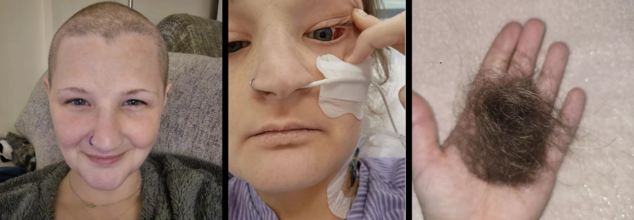- Health Conditions A-Z
- Health & Wellness
- Nutrition
- Fitness
- Health News
- Ayurveda
- Videos
- Medicine A-Z
- Parenting
- Web Stories
World No Tobacco Day 2025: Does Smoking Affect Women Differently Than Men?

Credits: Canva
On World No Tobacco Day, Dr. Sajjan Rajpurohit, Senior Director of Medical Oncology at BLK-Max Super Speciality Hospital, sheds light on how tobacco affects women differently than men. While the overall dangers of smoking are well known, Dr. Rajpurohit emphasizes the need to understand the biological, hormonal, and social dimensions that make women more vulnerable to tobacco-related diseases and challenges in quitting.
Biological Differences Make Women More Sensitive to Nicotine
“Women metabolize nicotine more slowly than men, which results in prolonged exposure to its harmful effects,” says Dr. Rajpurohit. This slower metabolism, combined with hormonal changes across a woman’s life—such as during menstruation, pregnancy, or menopause—can heighten nicotine’s addictive properties.
For instance, estrogen, a key female hormone, may increase sensitivity to nicotine, making it harder for women to quit. “This also explains why withdrawal symptoms might be more severe in women,” he adds.
Higher Risk of Certain Diseases
Women who smoke are more susceptible to certain diseases than their male counterparts, warns Dr. Rajpurohit.
Lung Cancer
Though men historically had higher rates of lung cancer, the gap has narrowed as more women took up smoking. “Women are not only developing lung cancer at younger ages, but they may also face more aggressive forms of the disease,” he says, pointing to biological differences in lung structure and function.
Heart Disease
Smoking significantly raises the risk of heart disease in women, especially those using hormonal contraceptives. “Smoking can cause the arteries to harden and increases the risk of heart attacks and strokes. When combined with birth control pills, the risk becomes even higher,” he explains.
Reproductive and Pregnancy Complications
Smoking affects fertility and reproductive health. It can lead to complications such as ectopic pregnancies, miscarriage, preterm delivery, and low birth weight. “Women in their childbearing years should be especially cautious, as smoking during this period can have lasting effects on both the mother and child,” Dr. Rajpurohit stresses.
He also highlights severe pregnancy-related risks like placental abruption (where the placenta detaches from the uterus) and placenta previa (when the placenta blocks the cervix), both of which can endanger maternal and fetal health.
Hormonal Imbalance and Fertility Issues
Nicotine disrupts hormonal balance, impacting ovulation and menstrual cycles. Women who smoke often report irregular periods and find it more difficult to conceive. “The damage is not just temporary—prolonged tobacco use can lead to long-term reproductive challenges,” says Dr. Rajpurohit.
Why Women Find It Harder to Quit
Quitting smoking can be a more difficult journey for women due to psychological, hormonal, and social factors.
“Many women smoke to manage stress, anxiety, or depression. This emotional dependence can complicate their efforts to quit,” Dr. Rajpurohit explains. Hormonal fluctuations during the menstrual cycle can also influence cravings and mood, making it harder to resist smoking.
Additionally, women may lack adequate support from family or peers. “Social encouragement plays a huge role in smoking cessation, and women often find themselves without the backing they need,” he says.
To help women quit, he recommends a tailored approach involving behavioral therapy, nicotine replacement therapy (NRT), and personalized quit plans. “These strategies must take into account individual stressors, emotional needs, and social settings,” he adds.
Secondhand Smoke and Societal Pressures
Women are often exposed to secondhand smoke in domestic environments, putting them at risk for the same diseases as smokers. “The dangers of passive smoking are real and can lead to respiratory illness, heart disease, and even pregnancy complications,” says Dr. Rajpurohit.
He also draws attention to how societal norms and advertising have historically influenced women’s smoking behavior. “Tobacco companies once marketed cigarettes to women as symbols of empowerment and liberation. Unfortunately, this portrayal led many to underestimate the health risks,” he notes.
In certain cultures, smoking among women may be normalized or not taken seriously, which further prevents intervention and support.
Empowering Women Through Awareness and Support
“Women face unique challenges when it comes to tobacco use, and we must address them with empathy and targeted strategies,” Dr. Rajpurohit concludes. On World No Tobacco Day, he urges women to seek help and become aware of the specific risks they face.
For those struggling with tobacco addiction, he recommends consulting healthcare professionals and exploring support systems that cater specifically to women’s needs. “The goal is not just to quit but to stay tobacco-free for life,” he says.
Weight-Loss Drug Ordered Online Leaves UK Woman With Hole In Esophagus

Credits: Kennedy News and Media
tIn an age of quick fixes and instant results, the promise of rapid weight loss—especially through online pharmacies—can feel like a miracle. But behind the glossy ads and glowing testimonials lies a growing and dangerous trend: self-medicating with powerful weight-loss drugs without proper medical guidance.
Aimee’s Story: A Search for Help Turns Life-Threatening
Aimee Chapman, a 34-year-old from Southampton, had been struggling with her health for some time. Like many others, she hoped that shedding some weight might ease her symptoms and help doctors take her more seriously. When she came across weight-loss injections online, they seemed like the perfect solution—easy to order, promising fast results, and no waiting room required.
And at first, they worked. Within just four months, Aimee lost nearly 60 pounds. But soon, the results took a terrifying turn. She felt weak, dizzy, and collapsed frequently. She stopped eating and began vomiting—sometimes up to 60 times a day. When she saw blood in her vomit, she still thought it was a virus. But her body was telling a different story.
One day, after experiencing severe chest pain, Aimee was rushed to the hospital. What doctors discovered was both rare and dangerous: a hole in her esophagus—the tube that carries food from the mouth to the stomach. This hole allowed food and fluids to leak into her chest cavity, risking deadly infections. Her liver also began to fail, and she was immediately taken to the ICU.
The Medical Warning Signs
Aimee spent two weeks in the hospital. Though she narrowly avoided needing a liver transplant, doctors confirmed the cause was linked to the weight-loss injections—but couldn’t determine exactly how the damage occurred. Even after being discharged, her body continued to show signs of distress: she lost large amounts of hair, likely from nutritional deficiencies caused by the sudden and drastic weight loss.
Her story serves as a powerful reminder that “easy” weight loss solutions can come with life-altering consequences.
The Real Risks of Self-Medicating
Aimee’s experience is not an isolated one. As the popularity of online weight-loss treatments grows, so do the risks—especially when people bypass healthcare professionals. These medications often contain powerful ingredients that can have serious side effects, interact with existing health conditions, or, in rare cases like Aimee’s, cause permanent damage.
Many online sellers are not regulated, and the quality and safety of the drugs they offer cannot be guaranteed. What seems like a shortcut can quickly turn into a health emergency.
Your Health Deserves Medical Oversight
If you’re considering weight-loss treatments, always speak with a qualified medical professional. A trusted doctor can help you explore safer, personalized options—whether that means supervised medication, dietary plans, or lifestyle changes.
Don’t Wait! Why Women In Their 40s Should Prioritize Breast Cancer Screening Now

Breast cancer doesn’t always announce its arrival with symptoms. In fact, the most dangerous cases are often those that go unnoticed—until it’s too late. A landmark study published in Radiology: Imaging Cancer (May 30, 2025) has reignited the debate around the age at which women should begin breast cancer screening. The results are sobering: nearly 73% of women in their 40s discover they have breast cancer only after symptoms emerge—by then, the disease may already be in an advanced stage. This makes a compelling case to rethink our approach to breast health: screening in your early 40s isn't just advisable, it's lifesaving.
Until recently, many health organizations hesitated to recommend mammograms before age 50. However, this new study led by Dr. Jean Seely, Professor of Radiology at the University of Ottawa, brings a critical shift in perspective. Tracking over 800 women aged 40 and above diagnosed with breast cancer in 2016, the research shows stark outcomes between those diagnosed through routine mammograms and those diagnosed due to symptoms.
Patients whose cancer was found only after symptoms appeared were 63% more likely to die from the disease. They were also 6.6 times more likely to have advanced-stage cancer and more than twice as likely to need a mastectomy.
This isn't just a statistical concern—it’s a call to action. Recent updates in screening guidelines reflect growing acknowledgment of this risk:
U.S. Preventive Services Task Force now recommends biennial mammograms for women aged 40 to 75. The American Cancer Society advises annual screenings starting at age 45, but leaves the option open for women in their early 40s to begin earlier.
Canada, on the other hand, continues to recommend screening beginning at 50—a delay that could be costly in terms of lives and outcomes, according to Dr. Seely.
This disparity in national guidelines underscores the importance of individualized care and proactive decision-making. If you're in your 40s, the evidence strongly favors starting screening now.
Hidden Damage of Delayed Detection?
What does it actually mean to discover breast cancer after symptoms appear? Symptoms typically include:
- A palpable lump
- Skin or nipple changes
- Discharge
- Breast pain
- Swollen lymph nodes
At this stage, cancer has often spread beyond the breast tissue, requiring more invasive treatment and carrying a significantly reduced survival rate.
In Seely’s study, nearly 20% of the women had died within 6.7 years, half due to breast cancer. For those diagnosed via symptoms, the disease was often more aggressive and more difficult to treat.
Despite the anxiety they may provoke, mammograms remain the most effective early detection tool. They can identify breast abnormalities years before they’re large enough to be felt or cause symptoms.
Other imaging tools include:
Breast Ultrasound: Often used to further evaluate abnormal mammogram results.
MRI: Recommended for high-risk individuals or those with dense breast tissue.
Biopsy: Performed only when there is a suspicious area needing confirmation.
While some may be concerned about false positives or discomfort during the test, the benefits of early detection far outweigh the risks.
Does Breast Pain Mean Cancer?
Many women assume that pain signals cancer. The truth? Only 1% of breast cancer diagnoses stem from pain alone. In fact, cancerous tumors are usually painless until they become large or spread.
Instead, the most common symptom is a hard, irregular lump—often described as feeling like a rock in tofu, according to medical professionals. By the time pain arises, the cancer has often reached a more advanced stage. This highlights why relying solely on physical signs can be misleading and even dangerous.
What About Benign Growths In The Breast?
Mammograms may also detect benign tumors, such as fibroadenomas or cysts. While the word “tumor” can spark fear, many of these are harmless and even shrink with age. The key difference? Benign tumors don’t spread to lymph nodes, unlike their malignant counterparts. That’s why ongoing imaging and follow-up are vital—to distinguish the harmless from the harmful.
Early 40s can be a whirlwind: careers, caregiving, personal growth. Breast cancer screening often takes a back seat—but it shouldn’t. Skipping a mammogram today could mean facing an aggressive disease tomorrow.
Health care providers are not only equipped to diagnose but also to reassure. Many screening results turn up nothing alarming. Yet when they do catch something early, they save lives. If you're unsure, schedule a conversation with your doctor. Together, you can weigh personal risk factors—family history, genetics, lifestyle—and chart a screening plan that safeguards your future.
Dr. Seely’s research is already prompting reconsideration of national screening policies, particularly in Canada. With data now clearly supporting screening starting at age 40, the push for universal early screening is gaining momentum.
Until then, individual choice remains your most powerful tool. Don't wait for symptoms. Don’t wait for age 50. Don’t wait at all.
Breast cancer is more treatable and survivable when caught early. Starting mammograms in your early 40s isn’t just a medical recommendation. It’s a personal insurance policy against the unforeseen because the earlier you detect breast cancer.
Not Cleaning Your Face Before Sleeping? These Tiny Bugs Might Be Feasting On Your Skin

Credits: Health and me
You may assume falling asleep without washing your face is just a lazy-night ritual but what if skipping that speedy cleanse invited an invisible microscopic to call your skin home? Say hello to Demodex folliculorum, the teeny microscopic mites that live, feed, and even reproduce on your face — most especially at night. While they're a natural part of the skin ecosystem, abandoning skincare can cause these little critters to thrive in some uncomfortable manners.
Demodex mites are tiny, eight-legged invertebrates that live on the human face, specifically in and around hair follicles. They are just 0.15 to 0.4 millimeters in size, invisible to the naked eye but numbering dozens or even hundreds at times — as many as five per square centimeter of skin. That may sound creepy, but almost every adult human carries these mites. They exist mainly on sebum (your natural skin oil) and dead skin cells, performing a pretty harmless, even cleaning function in normal circumstances.
Consider them micro custodians: they suck up the skin flakes and extra oils that collect during the day. But when their numbers get out of hand, which typically happens due to poor hygiene or compromised immunity, their presence becomes a problem.
What Happens While You Sleep 'Mite-fully'?
Demodex mites are active at night. They come out of your pores when the sun sets, excelling in the lack of UV light — which is toxic to their DNA. As you sleep, they dine, crawl, and mate on your skin's surface. What's even more interesting (and somewhat alarming) is that they're fueled by melatonin, a hormone your body makes to assist in sleeping.
For their services to clean our pores, we unwittingly provide them with melatonin as fuel — a strange, symbiotic relationship that only shows up if something goes amiss.
When They 'Mite' Cause Trouble?
While harmless in small quantities, Demodex mites can lead to skin problems if they overpopulate — a condition known as demodicosis. In the opinion of Dr. Richard Locksley, a professor of medicine at the University of California, San Francisco, such overpopulation can lead to a variety of skin and eye conditions, including:
- Rosacea
- Blepharitis (eyelid inflammation)
- Acne-like breakouts
- Itchy, inflamed skin
Immunocompromised people are especially vulnerable. When your immune system can't keep mite numbers in check, allergy and infection can follow. Ironically, your own sleeping habits — or lack thereof — can determine their level of activity. Lack of sleep boosts oil secretion, which provides mites with even more to munch on.
How Skipping Face Washing Adds To the Mite Population?
Letting makeup, grime, sunscreen, and impurities sit on your skin overnight can provide an all-you-can-eat buffet for Demodex mites. Left behind, these layers seal excess oil and dead skin cells — prime breeding ground for mites.
This is particularly troublesome in the area around the eyes. Eyelash follicles tend to be a breeding ground for mite overgrowth, particularly when mascara, eyeliner, or false lashes are not removed effectively. This results in irritation, plugged glands, and increased susceptibility to such conditions as blepharitis.
One of the most fascinating findings appears in a 2022 paper in Molecular Biology and Evolution, which indicates Demodex mites are becoming permanent residents of the human body — literally. Scientists discovered that the mites are losing unnecessary genes as a result of their snug, predator-free existence on human faces.
Actually, their body structures are so sparse that single-cell muscles control each of their legs. They also have a reverse process of maturation — losing cells as they mature rather than adding them. Since such close biological incorporation, scientists believe that one day they will be able to integrate genetically with human hosts. It may sound like science fiction, but it's a possibility biologically.
Should You Be Worried?
For healthy individuals, there's no reason to panic. Demodex mites are not dangerous per se. In fact, they're so widespread they're actually thought of as part of the skin microbiome. But they can become an issue when individual hygiene is lax — especially before bedtime. Here's what you can do:
- Always wash your face at night. Use a light, non-comedogenic cleanser that strips away oil and debris.
- Remove eye makeup and false lashes. These are usual sites mites over-colonize.
- Don't neglect your sleep. Lack of sleep heightens sebum production, inviting mites to flourish.
- Consult a dermatologist if you have persistent redness, itchiness, and inflammation in the skin.
Your evening skincare routine isn't vanity, it's a defense system against an unseen, millennia-old species that lives on your face. Though Demodex mites are generally harmless housemates, bad hygiene and broken sleep habits can cause them to become freeloaders with no plans to leave.
© 2024 Bennett, Coleman & Company Limited

